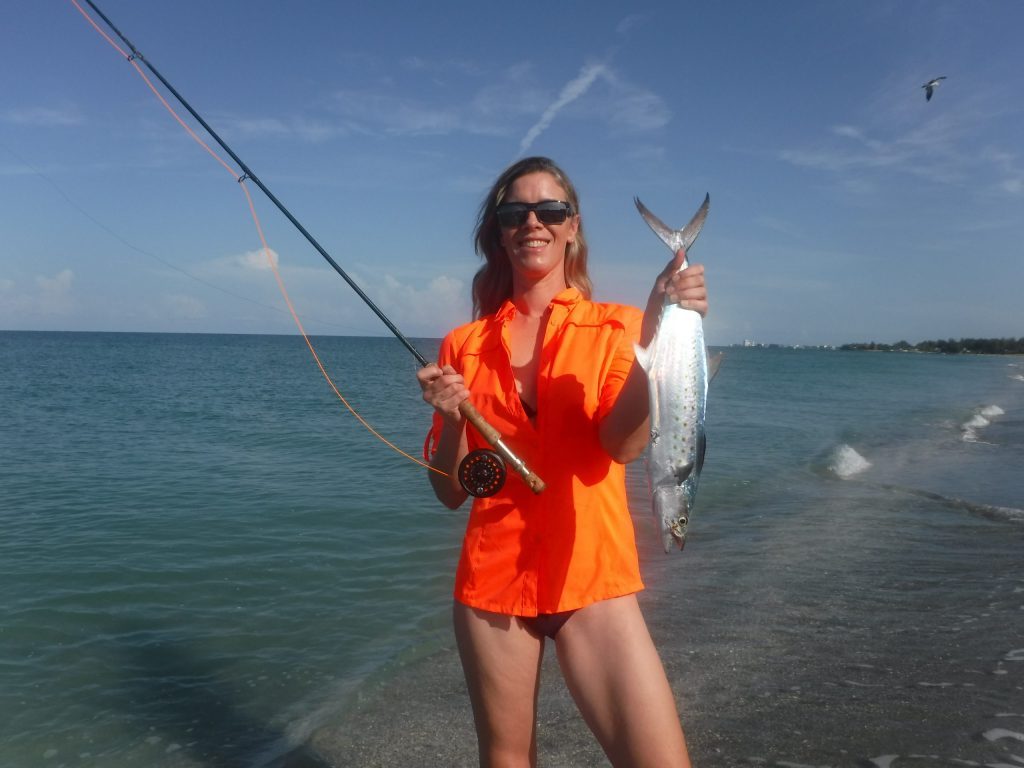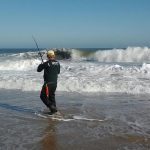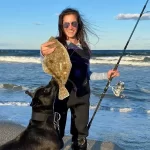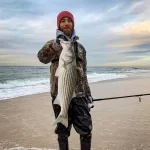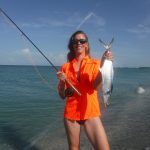Surf Fishing in Florida – Tackle, Baits, and Techniques!
The topic of this article will be surf fishing in Florida. There are 1350 miles of Florida coastline, and much of it is accessible to anglers. This offers both visiting and residential anglers the opportunity to enjoy some great fishing without the hassles of a boat.
Surf fishing is the act of casting lures or natural baits from the beach out into the Atlantic Ocean or Gulf of Mexico. The vast majority of the Florida coastline consists of barrier islands and beaches. This results in anglers having access to great fishing for a wide variety of species.
While surf fishing in Florida is relatively uncomplicated, there are still many factors and techniques that will affect how successful an angler will be. In this article, tackle, rigs, techniques, conditions, and species will be covered.
Surf fishing in Florida – best tackle
Anglers surf fishing in Florida can use the same inshore equipment used for other species, if the conditions allow. Unlike surf fishing in the northeast, the surf is often quite mild. This allows anglers to cast lures and baits with fairly light tackle. A 7′ medium action spinning rod with a 3000 series reel spooled up with 10 lb monofilament or 20 pound braided line is an excellent combo.
Click to shop Amazon for Penn Battle spinning and surf combos
“Fishing Lido Key is a participant in the Amazon Associates Program, an affiliate advertising program designed to provide a means for sites to earn advertising fees by advertising and linking to Amazon. As an Amazon Associate I earn from qualifying purchases. ”
Serious anglers surf fishing in Florida will need a dedicated surf fishing rig. Fortunately, a quality outfit can be purchased at a very modest cost. These longer rods are designed to make long casts as well as keeping the line up over the crashing waves. A 10′ to 12′ rod is a good place to start for novice surf anglers, while some prefer longer rods, up to 15 feet in length. Most use braided line to make longer casts.
These two rod and reel combinations will cover all of the fishing situations an angler surf fishing in Florida will encounter, short of big sharks or large tarpon. Many anglers use the strategy of using the big surf rod to cast bait out a long way then using the lighter spinning outfit to cast lures in closer to the beach while waiting for a bite on the other rod.
Other Florida surf fishing gear
There are a few other specialty pieces of equipment that surf fishing anglers will need. Sand spikes are essential! These are PCV tubes that are pointed at one end that are shoved into the sand. They allow anglers a place to keep their rods and reels up off the sand. One of the challenges of surf fishing is dealing with sand getting into the equipment.
Check out this article on inshore saltwater fishing in Florida
Some surf fishing anglers also opt to use a cart. These clever little devices can be personally tailored to the equipment an angler uses and the type of fishing that he or she does. They can be extremely convenient especially if the gear has to be hauled a little distance from the vehicle.
Florida surf fishing rigs
While some anglers surf fishing in Florida get quite fancy with their rigs, there really are just a couple of rigs that are needed to be successful. The basic bottom rigs that have been around a long time still work fine today. Anglers casting lures and live baits using light weights can use the same inshore rigging consisting of a 2′ piece of 30 lb shock leader attached to the running line using a swivel or line to line knot.
Spreader rig
One of the easiest and most effective rigs used by anglers surf fishing in Florida is the spreader rig. It is also known as a high/low rig or chicken rig. This rig allows anglers to present multiple baits (usually two) and multiple depths. The bottom hook is right on the bottom and the second hook suspends just a bit above.
Anglers have several options when using this rig. Hooks can be tied right on the running line or leader, then a sinker is attached. Commercially made rigs are available at every shop that caters to anglers surf fishing as well. Hook size will vary depending on the species being targeted. #2 or #4 hooks are good for most smaller species such as whiting and pompano. A pyramid sinker is used as the anglers want the rig anchored, not drifting with the current.
Fish finder rig
The fish finder rig is a staple among anglers surf fishing in Florida. It is a variation of the Carolina rig used by anglers freshwater fishing. The running line passes through a clever device, then a swivel is tied on. The swivel stop the sinker from sliding. A clip on the device allows for a quick sinker change as conditions change. Pyramid sinkers are normally used, though bank sinkers can be used as well. Anglers can omit the fish finder device and simply use a sliding egg sinker as well.
A leader is attached to the other end of the swivel. Leader lengths vary, but 2′ to 4′ lengths are most often used. A hook it then tied on. This hook should match the bait being used and fish being pursued. Often times, a larger cut bait is used with this rig to target larger fish. Some anglers prefer a circle hook to increase hook ups and help prevent fish mortality. A small float can be used near the hook to raise the bait up off the bottom a bit of desired. This is usually done if sharks and rays or skates become a nuisance.
Florida surf fishing techniques
Anglers surf fishing in Florida can you several different techniques in order to be successful. The most commonly used and most productive technique is to bottom fish with bait, either live, fresh dead, frozen, or commercially available. Anglers can also cast lures such as jigs, spoons, and plugs in search of feeding fish. Fly fishing can also be quite productive when conditions are optimum.
Bottom fishing
As previously mentioned, bottom fishing is the most widely used and productive technique used by anglers surf fishing in Florida. It is fairly simple and uncomplicated, however there are nuances and adjustments in technique that will result in a better catch. Anglers who experiment with different rigs, baits, and locations will usually experience a higher rate of success. However, there is nothing wrong with taking a an easy and relaxing approach and enjoying a day out on the beach.
Many anglers who bottom fish when surf fishing will use multiple rods with different rigs and baits in order to find what the fish want that day. The heavy rod is most often set up with a fish finder rig and a larger chunk or strip of cut bait. This rod is generally looking for the bigger fish such as a large red drum, bluefish, or shark.
Another rig can be set up with a spreader rig and slightly smaller hooks. This is the perfect rig for catching pompano, whiting, small bluefish, silver trout, sheepshead, and other species. This one-two approach works quite well. If anglers do not have any interesting catching a shark or other large fish, several rods can be rigged up with the spreader rig and fished at different distances from the beach as well.
Best bottom fishing baits in Florida
Angler surf fishing in Florida also have quite a variety of choices when it comes to bait. Perhaps the best all round bait used either live or frozen shrimp. They are widely available at every Florida bait shop and will catch every species that swims. The only real downside is that strength is not stay on the hook as well as some other bait.
Cut bait is very popular ineffective and stays on the hook quite well. Anglers can purchase bait fish either frozen or fresh at the local tackle shop along with squid. Most anglers use a light rig to catch their own bait fresh and then use it as cut bait. Generally speaking, the fresher the bait the better. Anglers do need to be aware of local regulations to make sure they are in compliance.
Live bait fish can certainly be used by anglers in Florida surf fishing as well. Serious anglers will use a cast net and catch their own live bait than keep them alive in an error rates it bucket. Herring, sardines, pin fish, grunts, and really any other little fish caught in the surf will work. Live bait fish will generally catch larger fish but are not as good on whiting and pompano. A fish finder rig works best to let the bait fish swim around naturally on the bottom.
Sand fleas are a very popular bait among angler surf fishing in Florida. Their true name is “mole crab” but everyone calls them sand fleas. They are a small crustacean about the size of a thumb nail. Anglers can catch these in the surf using a special device called a sand flea rake. Some bait shops sell them live and frozen. Serious anglers chasing pompano consider them the most effective bait for that species.
Commercially available baits have become popular of late. “Fish bites” in particular are very popular among angler surf fishing all over the East Coast of the United States. They are productive, stay on the hook well, and are convenient. There is no need to deal with messy bait or deal with the hassles of live bait.
Surf fishing with artificial lures in Florida
Anglers can certainly be successful casting artificial lures off of the Florida beaches as well. This is best done during periods of light surf for several reasons. It is difficult maintaining tension on the line in contact with the lure and a heavy surf. Also, a rough surf will result in churned up waters where it will be difficult for game fish to see the lure. However, when the surface calm in the water is clear, artificial lures can outproduce natural bait.
Most of the fish caught by anglers casting artificial lures will be done so fairly close to the beach, often times in the first trough. This first trench between the beach in the first sandbar is a natural feeding station for game fish as a variety of live bait fish and crustaceans will be found there.
Top artificial lures for surf fishing in Florida
The top lures used by anglers surf fishing include jigs, spoons, and plugs. The same basic artificial baits that produce for anglers fishing inshore for other species do find out on the beach as well. A white buck tail jig or a jig with a soft plastic body is very effective when conditions are calm. The best technique is to cast the jig out allowed to fall to the bottom and then retrieve it back in using short quick hops. Anglers can tip the jig with a small piece of shrimp to increase productivity.
Silver spoons are excellent surf fishing lures as well. There are an excellent choice when the surf is a bit rougher or on windy days, as they are heavier and cast quite well. It is also easier to stay in contact with a heavier lure on these days. In most situations, a fairly aggressive and erratic retrieve works best.
Read more about the best surf fishing lures
Plugs can be productive when fished off the beach as well. Top water plugs are an excellent choice early and late in the day or when fish are seen feeding on the surface. Shallow diving or subsurface plugs along with lipless crank baits are a good choice to cover a lot of water fairly quickly. In most cases, plugs and spoons will catch the more aggressive species such as bluefish, ladyfish, mackerel, jacks, and trout.
Fly fishing off of Florida beaches
Fly fishing off of the Florida beaches is great sport! This type of fishing does require for calm surface conditions as well as clear water in order to be successful. Spanish mackerel, bluefish, ladyfish, jacks, and other species can be caught by anglers casting a fly from the beach. Sight fishing for snook can be fantastic as well.
A 7 wt to 9 wt saltwater fly fishing outfit with an intermediate sink tip line is the best all round choice when fly fishing in the surf. An 8 foot to 9 foot tapered leader with a 30 pound bite tippet completes the rig. Fly choice is pretty simple, most anglers go for a weighted fly such as a Clouser Minnow or Crystal Minnow to get down in the water column a bit.
Surf conditions have a huge impact
The most challenging aspect that anglers surf fishing in Florida face is dealing with ever changing conditions. Often times, conditions will dictate the fishing, sometimes for good and sometimes for bad. There will be times when anglers drive to the beach and realize that they just will not be able to fish or have success if they try.
The three main conditions that affect surf fishing are weeds, wind, and wave height and water visibility. Wave height and water visibility are tied together, as highways will result in startup in dirty water. Wind is tied into that as well. Weeds and grass are another element that angler surf fishing in Florida will have to deal with.
There will be times when the water close to the surf will become very thick with grass and other weeds. This can make fishing difficult, if not impossible. Anglers will constantly have to clean the weeds off their bait and line, and it can just be frustrating as well is unproductive. When this condition occurs, anglers will just have to try another spot or even move to the bay side to fish.
Waves and rough and dirty water are conditions every angler surf fishing in Florida will have to deal with at some time. This is particularly true on the East Coast where the wave action is generally higher. There are some adjustments anglers can make. Fishing with larger pieces of cut bait may often be the best choice. These baits will stay on the hook longer and fish can find them easier.
Longer rods which get the line up over the crashing waves may help as well along with getting the bait out further from the beach and into cleaner water. Sometimes fish will move in very close to the shore on a rough surf, particularly black drum. The surf will stir up crabs and other crustaceans which they like to feed on. Fishing with artificial lures and a rough surf is generally difficult and unproductive.
Florida surf fishing species
One of the aspects of surf fishing in Florida, and saltwater fishing in general, is that anglers never know what they will catch. Most spots offer the chance to catch a variety of species from hand sized fish to giant swing several hundred pounds. While just about every species that swims in Florida can be caught from the surf, several of the top species will be listed below.
Top Florida surf fishing species
-
Pompano
-
Whiting
-
Flounder
-
Spanish mackerel
-
Sharks
-
Redfish
-
Snook
-
Trout
-
Sheepshead
-
Bluefish
-
Black drum
Pompano
Pompano are without a doubt one of the top, if not the top, species targeted by anglers fishing off of Florida beaches. While they certainly put up a respectable fight, the reason for their popularity as is much how they are prized on a dinner plate. Pompano are fantastic eating, perhaps the best that there is.
One look at a pompano’s mouth will let anglers know how it feeds. Pompano cruise along the bottom vacuuming up crabs and other crustaceans. Therefore, the best baits for them are live and fresh dead shrimp, sand fleas, and commercially available baits. Pompano do have a small mouth so a #4 or cell hook works quite well.
They can be found anywhere in the surf from right on the beach to as far out as an angler can cast. Anglers fishing for them on the East Coast of Florida will often have to make very long cast out over the breaking waves. Pompano are most plentiful in the cooler months. On the West Coast of Florida, they are often found quite close to shore and can be caught by anglers bouncing a jig off the bottom. They are seldom caught on live bait fish or cut bait.
Whiting
Whiting are another very popular species that are caught in the surf. They are popular all up and down the East Coast, being known by the term surf mullet in the Outer Banks area and king fish off of Virginia and Maryland beaches. Whiting are similar to pompano when it comes to the shape of their mouth and therefore feeding habits. They have an inferior mouth, which means their nose protrudes past their mouth and they mostly feed on the bottom.
Whiting are mostly caught by anglers using shrimp for bait, though they will hit cut bait and shrimp-tipped jig’s as well. Smaller hooks work well, just as with pompano. Though not large, they put up a respectable tussle for a fish of their size and are excellent eating. Whiting do school up, and once located a bunch of fish can be caught in short order.
Flounder
Flounder are another species that are prized by anglers surf fishing in Florida. They are bottom feeders as well and therefore the baits and techniques used to catch other species will produce flounder as well. Anglers specifically targeting them usually use a fish finder rig with a long slender strip of cut bait or squid. Live minnows can be very effective as well.
Flounder will certainly hit shrimp, sand fleas, and prepared baits as well. At times, especially on the West Coast of Florida, anglers will catch them bouncing a jig on the bottom. Flounder will often move and quite close to shore, especially when conditions are calm. Flounder are fantastic eating with a very mild white fillet. Anglers will often use a piece of the white underside as cut bait once the first flounder is caught.
Spanish mackerel
Spanish mackerel are a beautiful and hard fighting game fish that are available to surf casters along the entire Florida coast line. They are usually present in the spring and the fall when the water temperatures are moderate. Spanish mackerel are usually found in large schools in the action can be chaotic when a feeding school moves along the beach.
While Spanish mackerel can certainly be taken on live or cut bait, they are most fun to catch when targeted using artificial lures or even flies. There are aggressive nature makes them a natural for being caught on lures. Anything that is erratic and flashy will fool them, Silver spoons are a great choice in most situations. Spanish mackerel are very good to eat when prepared fresh, they do not freeze well.
Sharks
Sharks are the largest species targeted by anglers surf fishing in Florida. They are fairly plentiful and widespread there are multiple shark species that anglers can catch. The vast majority are caught on purpose by anglers fishing with cut bait on the bottom. Sharks are usually not fussy, just about any chunk of meat will draw a strike. Serious anglers seeking large sharks will have someone paddle out in a kayak with their bait using heavy conventional tackle. Note; large sharks can be dangerous and some beaches prohibit fishing for them.
Redfish
Redfish, also known as red drum, are a commonly targeted and popular game fish that are caught off of the Florida beaches. These are one of the larger fish species that anglers will catch from shore. This is particularly true and Northeast Florida near Jacksonville, where large bull redfish are frequently encountered. However, fish of any size may be caught from the Florida beaches all along the coast to Pensacola.
Redfish are caught using a variety of techniques. On the East Coast of Florida, anglers use heavier tackle and larger chunk or live baits. This is due to boat the size of the fish and the conditions of the surf. On the West Coast of Florida and around to the Panhandle, anglers often catch them with artificial lures right in the first trough close to shore. Bottom fishing works as well. Redfish are very good to eat, however anglers need to stay up-to-date on the current Florida fishing regulations.
Snook
Snook are a prized species for anglers surf fishing in Florida. While a fish may take a live or cut bait meant for other species, most snook are caught by anglers purposely fishing for them. Snook will move out onto the beaches in late spring and summer as part of their spawning ritual. Anglers will walk the beach searching for fish which will be cruising right in the surf line close to shore. This is a great opportunity to sight fish for a large terrific game fish using fairly light tackle!
Often times the beaches closest to passes and inlets are the best spots to look for snook as most of the fish will have migrated out from the inshore bays and waters. They can be spooky in the shallow, clear water, so smaller lures and subtle presentations work best. A frisky live scaled sardine, pin fish, or finger mullet can be extremely productive. Snook are temperature sensitive and most of the fish will be found from the middle of the state south.
Trout
There are a couple of species of trout that anglers surf fishing in Florida may encounter. These are spotted sea trout, also known as speckled trout, and silver trout. They are similar in appearance though a bit different in habit. Silver trout, also knows as “sand trout” or “white trout” usually show up in the cooler months and are often found in larger schools. They are aggressive and will take shrimp, fish bites, jigs, and small pieces of cut bait. Once located, the action can be fast and furious. They are not as large as speckled trout, but put up a great fight and are very good to eat. They do not have the spots that speckled trout do.
Speckled trout are found off of the Florida beaches year-round. Most anglers fishing in Florida are familiar with this very popular and plentiful species. They do not like dirty water and walled not be found in the surf when it is stirred up. Speckled trout are more common on the beaches of the West Coast and Panhandle of Florida. Live shrimp and a jig with a soft plastic body are the top baits. Speckled trout are fantastic eating!
Sheepshead
Sheepshead are a hard fighting and great eating member of the porgy family. They are a favorite among anglers fishing from shore throughout the state of Florida. Sheepshead dined primarily on crustaceans and will rarely be caught on cut bait or artificial lures. Shrimp, sand fleas, and fiddler crabs are the top baits.
Sheepshead love structure and can often be found around jetties, rocks, and piers. However, they will be found cruising the surf at times in search of sand fleas and other crustaceans. Normally, this will occur in the first trough quite close to shore, especially on the West Coast. Sheepshead often bite very lightly and a sensitive touch is required in order to hook them. They are notorious for being excellent bait stealers.
Bluefish
Bluefish are a top species for anglers surf fishing in the Northeast part of the United States. They are a very hard fighting and aggressive game fish. Some Florida anglers consider them a nuisance as their teeth are sharp and they will cut off baits and lures intended for other species.
Most bluefish caught in Florida are done so in the cooler months, from October to April. They do not like the warm water and they most certainly do not like stirred up water. Artificial lures are great choice as it appeals to their aggressive nature. There is a mixed opinion as to the eating quality of bluefish, some anglers find them to be strong. Smaller bluefish are definitely the best eating and should be prepared that day.
Black drum
Black drum are a bit of a mix between their cousins the redfish and a sheepshead. They are similar in appearance to sheepshead, though a bit more elongated with a differently shaped dorsal fin. Like the sheepshead, black drum feed primarily on crustaceans, crabs in particular. While plenty of black drum are caught by anglers using shrimp, either live or dead, though specifically targeting black drum will usually use half a blue crab. They grow quite large, the Florida state record black drum is almost 100 pounds!
In conclusion, this article on surf fishing in Florida will help anglers be more successful when fishing off of the Sunshine State beaches!
